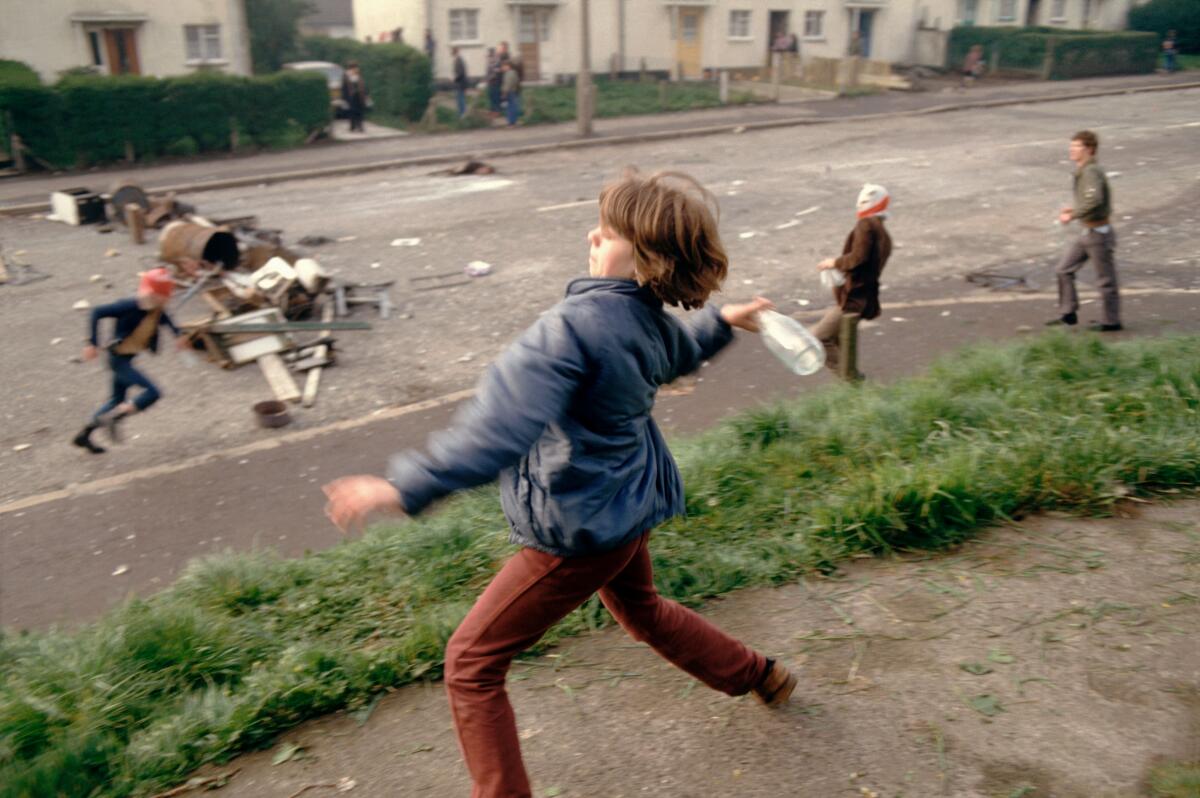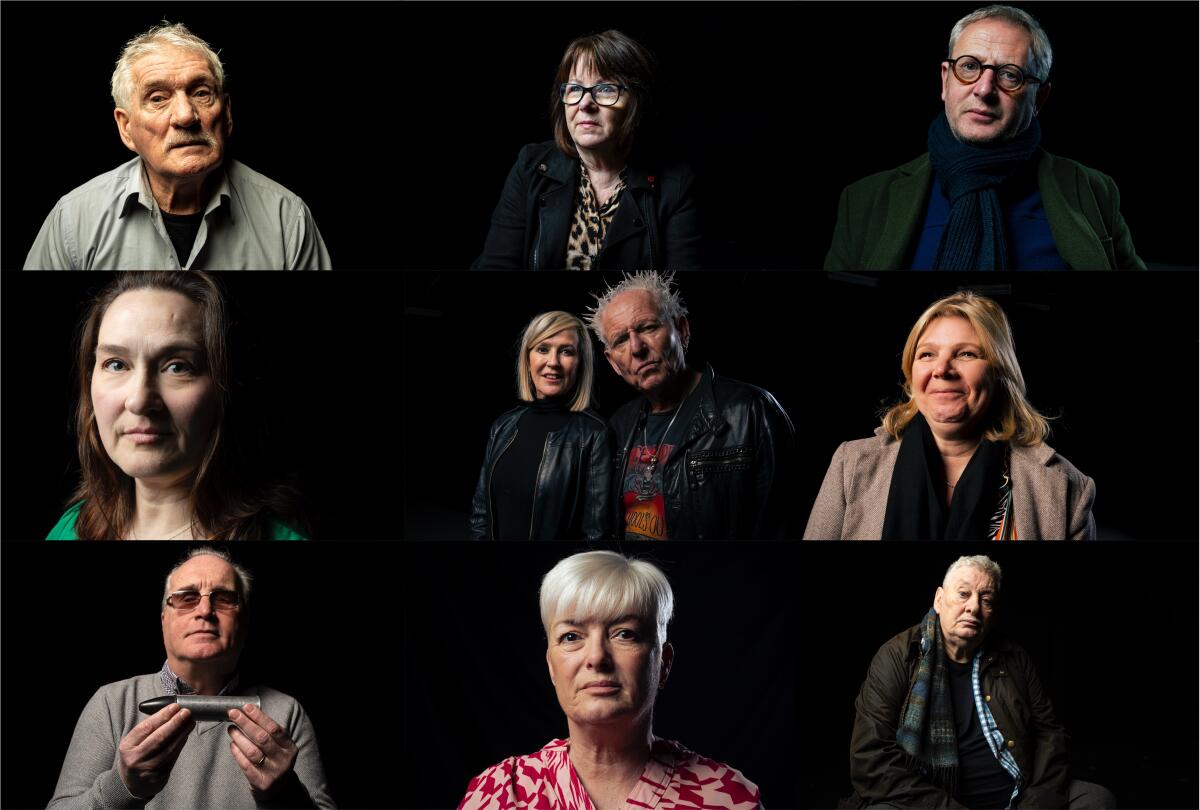Review: ‘Once Upon a Time in Northern Ireland’ grapples with the Troubles through emotional testimonies

- Share via
An oral history with pictures, “Once Upon a Time in Northern Ireland” (airing on PBS, Monday through Wednesday) is a five-part journey through the three-decade political-sectarian conflict familiarly and conservatively known as “the Troubles.” Driven by the reminiscences and observations of people who lived through it, it is something of a companion piece to director James Bluemel‘s 2020 “Once Upon a Time in Iraq,” about that country in the wake of the 2003 U.S. invasion. Like that film, it is less concerned with events themselves than with their human cost, personal, psychological, physical, philosophical.
Speakers come from all sides of the story — Catholics and Protestants, Republicans and loyalists, victims and victimizers, paramilitary members, police, punks, prisoners and prisoners’ wives and children, widows and orphans. Some are well known at home for their involvement in famous cases or as cultural figures, but all are essentially “ordinary.” There are no scholarly talking heads, no dispassionate journalists; political figures are seen only in archival footage.
Without going into the long, complicated and confounding history of the Irish under British rule, the story told here begins in the late 1960s, when Catholics in Derry and Belfast began to demonstrate for their civil rights. Since the 1921 partition of the island into what became the independent Republic of Ireland and British Northern Island, repressive laws had kept Protestant loyalists in power in the north. Protests were met with violence; the British army was called in. (Women from both sides brought soldiers tea and biscuits — for a time.) Catholic and Protestant paramilitaries came to life: terrorist fringes that considered themselves literally at war, initiating a spiral of intensifying violence that would eventually leave some 3,500 dead, most civilians, as they held the country hostage for 30 years.
Ricky O’Rawe, who would join the IRA and spend time in prison, remembers his Republican father and his associates early on “rubbing their hands and plotting and probably talking about raising an army to fight. It was tailor-made for them because they had an army right in front of them in a green uniform — the British Army. It was tailor-made for a revolution, and these guys went for it. They went for it like racing drivers.”
Although “Once Upon a Time” spends most of its time with those whose lives were upended or defined by the Troubles, we do get reminders that something like normal life went on. People fell in love, got married, had kids who played in the streets — albeit hard by barbed wire — and grew up and fell in love and got married. (Fans of the sitcom “Derry Girls,” in which the Troubles are part, but only part, of life, will have been schooled in this.) Patrick Kielty, whose father was murdered by loyalist paramilitaries, turned to comedy, performing sometimes in a terrorist balaclava: “You wanted to show people that this sadness you were carrying,” he says, “this brokenness you had, wasn’t everything about you.”

A section on the nonsectarian, anti-authoritarian Belfast punk scene focuses on Teri Hooley, who had a record store and label there, and declares that if his kids ever asked him what he did in the Troubles, “I wanted to say I partied a lot, I drank, did drugs and had a good time, and I didn’t kill anybody.” (His life became a pretty wonderful motion picture, the 2013, “Good Vibrations,” after the name of the store, which in turn inspired a stage musical; it traveled to New York earlier this year.) Of the Harp Bar, where the scene was centered, Yvonne Cowan, whose husband Greg was and is a member of the punk band the Outcasts, recalls, “You knew you were in a safe place. I mean, it was a dump, but it was our dump.”
While the causes, progress and end of the Troubles are broadly delineated and its major events dutifully remarked upon — Bloody Sunday, Bloody Friday, the Battle of the Bogside, the Maze prison hunger strikes, the 1998 Good Friday Agreement, which (more or less) brought the violence to an end — the strength of the series lies in how it honors those who have come to talk about them. If not a full accounting of the era’s politics and atrocities, it offers something equally valuable, an anecdotally authoritative, emotional history, as its subjects grapple with who they were then from the standpoint of who they are now. It leaves viewers free to reckon the merits of their testimony, and of the larger arguments that engulfed them — which isn’t to say the documentary has no point of view: Even as it avoids judging individuals, it is clearly (and uncontroversially) on the side of peace and tolerance and against violence, sectarianism, fanaticism and the oppressive tendencies of both authorities and revolutionaries.
The implicit theme of “Once Upon a Time in Northern Ireland” is, indeed, time, and the past that is always present, even for those able to move on from it. Speakers attempt to reckon honestly with their former selves; some are regretful, others unapologetic; some forgiving, some unable to forgive; some have struggled long with questions, others have had questions answered. There are those who recall the last words spoken to a murdered loved one, and others words they wish they’d said. There is laughter; there are tears. Bluemel shows them in moments of contemplation or hesitation many directors would edit out, but which humanize his subjects, and tell a deeper, ultimately hopeful sort of tale.
“You’re taking me to a bad place, James,” James Greer, who spent eight years in prison after a bombing attempt went haywire, tells Bluemel, admitting, “Just because you’re uncomfortable with it doesn’t mean it’s not there. And I hate to ignore the things that make me uncomfortable because they’re important … Are we going to get another cup of tea here?... I would kill you for a cup of tea.”
More to Read
The complete guide to home viewing
Get Screen Gab for everything about the TV shows and streaming movies everyone’s talking about.
You may occasionally receive promotional content from the Los Angeles Times.







